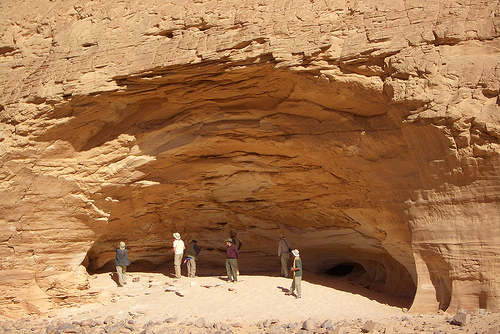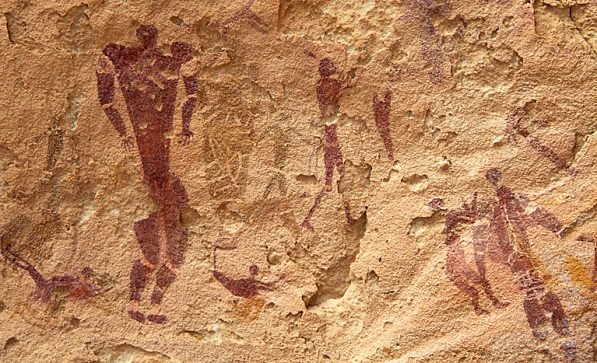

Location: Map

The Cave of Swimmers is situated in the South- Western part of Egypt
on the border with Libya on Gilf Kebir plateau. Cave of Swimmers was
re- discovered in October 1933 by Hungarian explorer László Almásy
this example of rock painting date back 12,000 years ago to the time
of Ice Age. Unlike today the climate in the region at the time was
much milder and richer in wild animals available for hunting. It
could be possible that the figures depicted on the cliffs of a small
cave might actually be depicting swimming since there were a lot
rivers and small lakes spread out on the plateau. Almásy devoted a
chapter in his book: "Unknown Sahara" and instantly the rock became
famous for its own good. Due to seclusion of the site there is no
way to stop or prevent vandalism from tourists. Some went as far as
washing the surface of the cave with wet clothes to get a better
picture, because it lasts longer. This barbarism in combination with
rough local climate led to appearance of multiple crevices in the
rock of Cave of Swimmers. To add insult to the injury some tourists
added graffiti to the prehistoric art.
If you curious why do
you have a feeling you saw Cave of Swimmers somewhere, the chances
are you did. It's copy made by modern artists was portrayed in the
movie: "The English Patient"
The cave and its paintings were discovered in October 1933 by Hungarian explorer and adventurer László Almásy. He devotes a chapter of his work The Unknown Sahara (1934) to this cave. In this chapter, he develops a thesis according to which these pictographs represent scenes of daily life in the region before the climate, then semi-humid tropical, changed and became that of a xeric desert. This idea was so innovative that its editors preferred to add footnotes inviting readers to be cautious and to dissociate themselves from it.
The “Green Sahara” period did indeed exist, from approximately 7500 to 2300 BC., although with strong fluctuations in rainfall. In 2007, Eman Ghoneim discovered the presence of an ancient mega-lake (30,750 km2) buried under the sands of the Great Sahara, in the north of the Darfur region, in Sudan. The Neolithic began in the Sahara a little later, around 5000 BC.
Some of the pictographs appear to represent human beings in a
swimming position. We also see ostriches, antelopes, giraffes and
hippos.
The German ethnologist Hans Rhotert, who conducted
research on the rock art of North Africa and the Middle East, was the
first to interpret the figures of swimmers as representations of the
deceased3. The French prehistorian Jean-Loïc Le Quellec agrees with this
interpretation. He compared these drawings to the texts of the
sarcophagi, which indicate that such figures are the souls of the
deceased floating in the primordial ocean Nun.
The cave is mentioned in Michael Ondaatje's novel L'Homme flambé (1992) and in its film adaptation under the title The English Patient. The cave that appears in this film is not the real cave, but a film set recreated for the occasion.